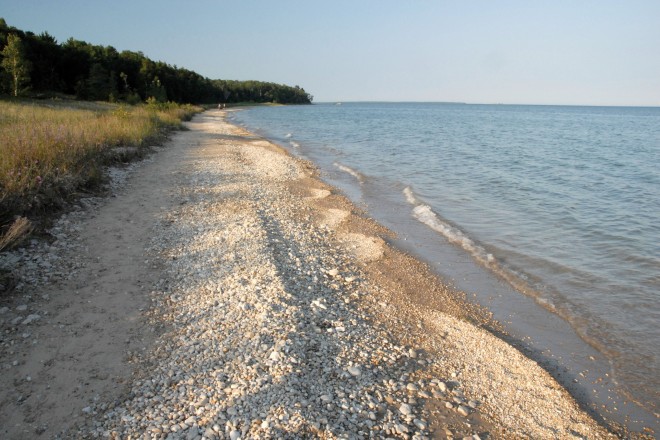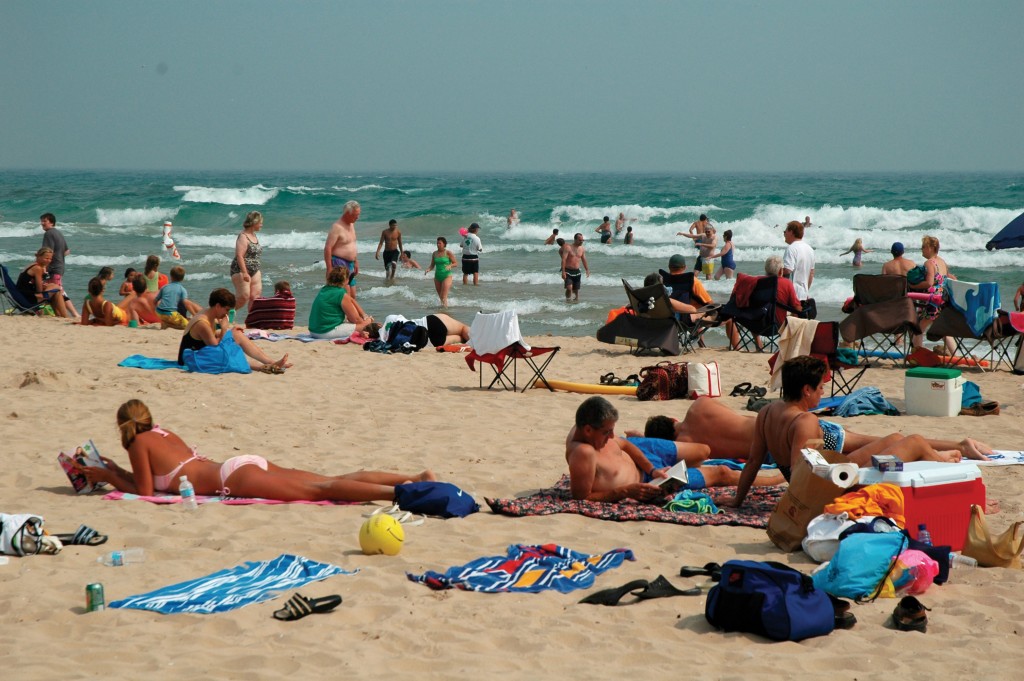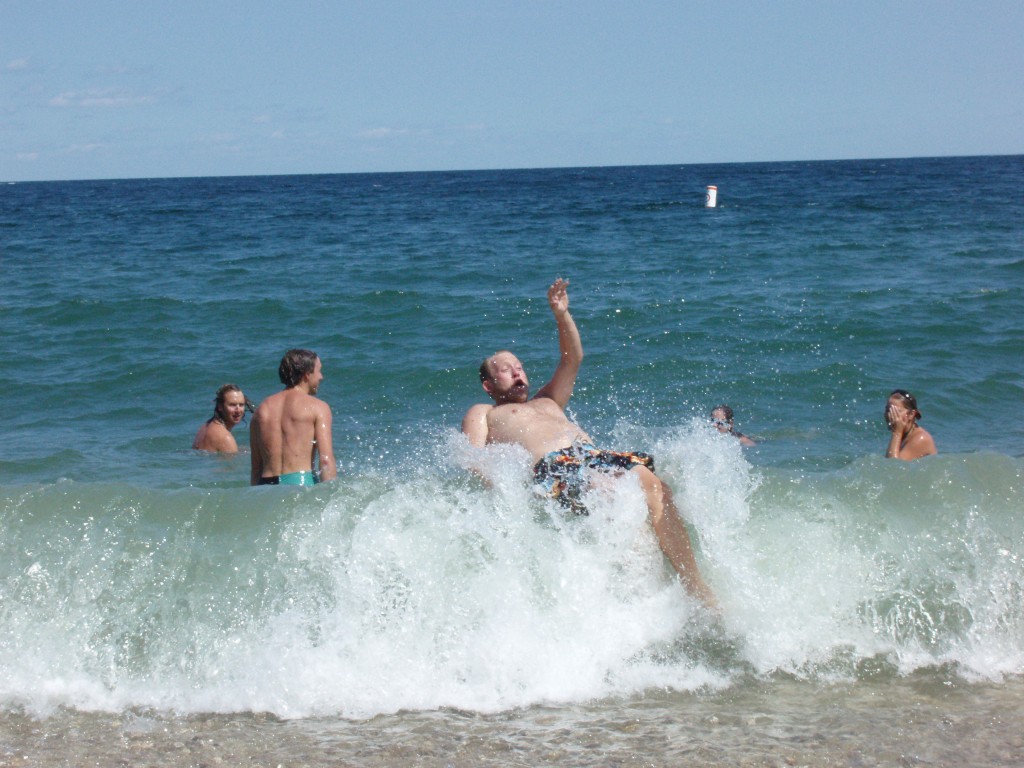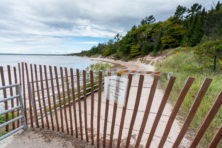Protecting Door County’s Beaches
- Share
- Tweet
- Pin
- Share

In an era of growth pressure, private development has dominated the battle for access and control of Door County’s treasured shoreline over the past two decades. But the county’s public officials have mounted a powerful rebuke in recent years, launching an 11th-hour effort to secure and protect the peninsula’s beaches for generations to come. After a 2002 water quality scare sent shockwaves throughout the community, the county undertook an extensive beach monitoring program and, in 2007, the communities of Sister Bay and Egg Harbor decided it was worth a tremendous investment to secure their beaches for the future.
In July of 2002, 68 people fell ill after swimming at Nicolet Bay Beach, one of the state’s most well-known and revered locales. What many feared would be a devastating blow to Door County’s tourism trade – the flood of bad publicity, the fear that the peninsula’s most treasured resource was tainted – has instead served as a wake-up call and pushed the county to the forefront of beach monitoring and maintenance.
“The county deserves a lot of credit,” says Jon Jarosh, Marketing Director of the Door County Visitor Bureau. “They turned a negative into a positive. They could have pushed it under the rug, but they didn’t want to be the mayor in Jaws saying ‘What shark?’ By being upfront and open they brought awareness of what was happening and what we need to do to take care of our beaches.”
It didn’t seem like a positive at the time. The most popular beaches in a community reliant on them were closed and nobody knew why. Business owners worried that the people who paid their bills would stop coming with the area’s chief draw in question.

When the water quality problems first arose, many speculated it was a result of the sewage pumped into Lake Michigan by the city of Milwaukee after major storm events. Others pointed the finger at Chicago and Green Bay, but after extensive testing and research the Door County Soil and Water Conservation Department (SWCD) determined the finger needed to be pointed inward. “It’s originating from us,” says Amanda Brown, a conservationist with the department, “not Milwaukee or Chicago.”
The illnesses stemmed from pathogens in the water, particularly E. coli. The pathogens come from a variety of local sources, such as dog feces, bird droppings, agricultural runoff and lawn chemicals, but the biggest culprit is storm water runoff. During major rain events, precipitation gathers chemicals, sediment, and pollutants from lawns and roads and takes it on a ride into storm drains, which inevitably lead to Lake Michigan. Decades ago, before storm water runoff was a common phrase, municipalities engineered their storm drains to run into the bay at the locations where they owned land – usually the beach. So today, all those pollutants are concentrated where we swim after heavy rains.
The problem has been exacerbated by shoreline development, which has created much more impervious surface on the waterfront, and the heavily fertilized and manicured lawns that accompany it. Instead of a last-ditch natural filtration system before storm water enters the bay, sediment, chemicals and pollutants instead pick up steam there.
But despite the rising tide of developments and human practices presenting challenges to the Door’s beach protectors, tremendous progress is being made. Closings and advisories were down in 2007, in large part due to the absence of major rain events, but also because the county and municipalities have taken significant steps to protect beaches and educate the public to be better stewards.
As a percentage, Brown says the peninsula’s beaches have fewer problems than others throughout the state, but due to the popularity of the county and sheer number of beaches – her department monitors 34 – problems in Door County garner more attention and concern.
Brown says the county’s municipalities should be applauded for taking a progressive approach to the problem. Eight are working with the SWCD and Miller Engineers and Scientists out of Sheboygan, Wisconsin to design better storm water runoff systems in an effort supported by grants from Wisconsin Coastal Management.
“They’re coming up with ways to better handle runoff,” she says. “Much of it is natural, such as planting native vegetation, but it also involves filtration systems and the re-routing of drain pipes. It’s really great to see that the municipalities recognize how important the beaches are.”

When Sister Bay’s sewer beneath Bay Shore Drive collapsed in 2004, they took the opportunity to install a special storm water treatment system at a cost of about $60,000. The system helped the village earn Beach Buddy recognition from the Natural Resources Defense Council (NRDC) in 2007. The council gives the award to communities that monitor beach water regularly and close beaches or notify the public when the Environmental Protection Agency’s maximum standards for contaminants are exceeded. It also recognizes those that have taken steps to improve sewage or storm water treatment.
This summer marks the fifth year that microbiology students from the University of Wisconsin-Oshkosh will spend their summer in Door County monitoring its beaches in partnership with the SWCD. Funding for the effort was obtained through the Beaches and Environmental Assessment and Coastal Health (BEACH) Act, federal legislation enacted in 2000 to initiate monitoring of beaches and public awareness of water quality problems.
Greg Kleinheinz, Assistant Professor of Microbiology at UW-Oshkosh, says his department works with counties throughout the state, but few approach the comprehensive nature with which Door County has attacked the problem. “Door County is a model not only for the state, but for the nation,” he says. “I feel people take it for granted what’s done in Door County to some degree. They’re taking the most pro-active approach of any place in terms of public health and beach quality. It’s all sort of a first nationwide and a great experience to be a part of.”
A handful of upper-level microbiology students descend on the county each summer to test beach water for pathogens. The Department of Natural Resources evaluates the amount of use each gets and that determines how often the beach is tested. The most frequented beaches are tested four times a week, the next tier two times, and least-used beaches are tested once per week.
Advisories are posted to warn swimmers when pathogen levels are elevated, and several beaches that have consistently tested positive for high levels of pathogens after rain events are now preemptively closed during and immediately after significant rainfall as a preventative measure.
In addition to providing an invaluable service to the county, the program is a popular one among Oshkosh students. “There’s no shortage of those interested in working up there,” Kleinheinz says.
“It’s a great experience,” says Brown, herself introduced to the county through the program while a student at Oshkosh. “Everyone wants to work in Door County, of course, but you also get field experience, lab work, and most of all you’re doing something that matters.”
While Kleinheinz wholeheartedly supports the increased attention given to beach health and water quality after the 2002 illnesses, he says there is a wide misperception about water quality as a result. “I would suspect the beaches are actually by far cleaner than years ago, but the testing has only been done the last few years,” he says. “Nobody ever looked before.”

Statistics from 2007 paint a picture of beaches in better health than some would suspect. Forty-three swimming advisories were posted in the county last summer, with six beaches closed a total of seven days. Nicolet Beach, which brought so much attention to the water quality issue, has had just 12 advisories and three closures in the five years since the initial incident. After getting the Beach Bum label from the NRDC in 2003, the county earned Beach Buddy status from the organization in 2005 and 2006, encouraging signs for a region whose economy relies on its public shores.
Now that people are looking, Kleinheinz believes the worst problems can be prevented. “If we had this program in place in 2002, the outbreak at Nicolet may not have occurred. Many of those who got sick might not have.”
Reclamation Project
For many, it was considered the final losing battle in the fight for a village’s soul.
In October of 2006 the owners of Helm’s Four Seasons resort, in the heart of Sister Bay, came to the village board with a proposal to build a 39-slip marina in conjunction with their previously approved plan to turn the resort into a condominium development. At the time it appeared yet another large and highly visible swath of quasi-public shorefront (though private, Helm’s owners had allowed kids to leap from its pier for decades) would be lost to the lords of yachts and profitability.
An October public hearing on the subject brought outcries from residents concerned it would destroy the small public beach beside it and smother the shorefront with breakwalls and sails. This is usually the chapter in the story where would-be developers dig in their heels, call the lawyers, and unleash verbal assaults on their opponents.
But Terry Zielke, the would-be developer in question, responded in a manner seldom seen on the peninsula.
He left the meeting a little shocked and defeated. Sister Bay is his town. His parents had opened the resort a half-century earlier when Door County was a different place and visitors were not demanding luxury at every turn. Families had returned for decades, but affordable hotel rooms weren’t paying the bills as they once had. Zielke seemed dismayed that his friends and fellow business owners didn’t sympathize, but he understood.

He had grown up in the village, leaping from the village dock and swimming at the beach everyone now feared was doomed. He left the meeting intending to go back to the drawing board to redesign the marina, but what emerged a few months later shocked residents, in a good way.
In April, the village board voted to purchase the property from Zeilke for $4.9 million with plans to demolish it to make way for a park in a move Village President Denise Bhirdo said, “will preserve and protect our beach for generations to come.”
The sale ended the 48 years of the Zielke family business on the site. “There’s a lot of blood, sweat and tears in it,” Zielke said. “But as long as the public retains access it’s a good move.”
Suddenly the village beach had gone from doomed to doubled in size, and Sister Bay’s future image transformed from one dominated by condos and catered-to wealthy boaters, to one of a waterfront community with access for beach-goers, silent sport enthusiasts, boaters, and swimmers.
Egg Harbor soon took similar action, purchasing the Richard Troup property adjacent to its public beach for $1.6 million, adding approximately 150 feet of shoreline to the public realm and further defying the losing streak the public had been in the throes of for the past three decades in its struggle against private development of the waterfront.
While supported by most, the purchases have caused their share of consternation. Egg Harbor and Sister Bay had to undertake heady borrowing projects for the buys, and taxpayers will be footing the bill.

Some worried about other unfinished projects in the villages, but ultimately those who felt it was imperative to take advantage of what was considered a “last best chance” to enhance the public shorefront won the day.
Door County’s Greatest Lure
For those who live here, the beaches are what pull us through the long winters. Visions of a couple months of warm summer sunsets and hot afternoons spent on the shore tug us through day after day, month after month, of wind, snow, and cold.
For those who visit, the postcard -perfect images of clean blue waters or memories of childhood vacations spent in the sand lure them back time and time again. Our shoreline, and more specifically our beaches, are what define Door County as a destination and a place to live. That’s a point not lost on Jon Jarosh, Marketing Director of the Door County Visitor Bureau.
“At the end of the day,” he says, “water access is the reason people come here. They may not always go and lay out for five hours, but just to look at it gives you that special feeling you get when you’re around water.”
Jarosh also recognizes that those who live here often take the natural splendor for granted. “Those things become second nature,” he says. “But people come from all over the world to see what is right here in our own backyard.”
One such place is the beach at Whitefish Dunes State Park, which has fashioned itself a special place among the peninsula’s favorites. One of the longest stretches of beach open to the public in the county, it was named one of “ten great American beaches” by Travel + Leisure magazine.
“It’s obviously a very special part of Door County,” Jarosh says. “It has great interpretive centers and a product that really resonates with people. They have a great ‘friends’ group always working to improve the park and adding things.”
Park Naturalist Carolyn Rock organizes the Big Red Tent on the beach Thursday through Saturday in the summer. The tent is host to children’s activities and educational programs, with beach toys available for lending to those who left something behind in the family rush to the beach. Rock has worked at the park since 1999 and doesn’t tire of hearing people swoon upon seeing the expanse for the first time. “It invokes a lot of good memories of other places and other times,” Rock says. “So often people walk out onto the beach and I hear some version of ‘Oh, this reminds me of…’ This beach is a unique feature that can’t be replicated.”
The beach is also one of the area’s most accessible, with a grid boardwalk friendly to those pushing strollers and wheelchairs or suffering from other ailments.

But “The Dunes,” as many call the park, is just one of more than 30 beaches the county has to choose from, each with a quality and character of its own. Nicolet Beach in Peninsula State Park is a hamlet for boaters, families, and those thirsty for activity, while Newport is a nature-lover’s paradise. For those in search of a different experience there are the beautiful stone stretches of Schoolhouse Beach on Washington Island or Pebble Beach in Sister Bay.
The variety of beaches coupled with the county’s unique geography are major factors in making Door County such a special destination. With so many shores in such close proximity, beach-lovers always have another option.
On the bay the beaches are generally smaller and busier, while those searching for a little room to relax are best advised to head to the quieter east side of the peninsula. “Weather will often dictate where to go,” Jarosh says. “On a windy day you’ll probably stay on the bay side, but on a really hot day you may want to hit the lake side.”




